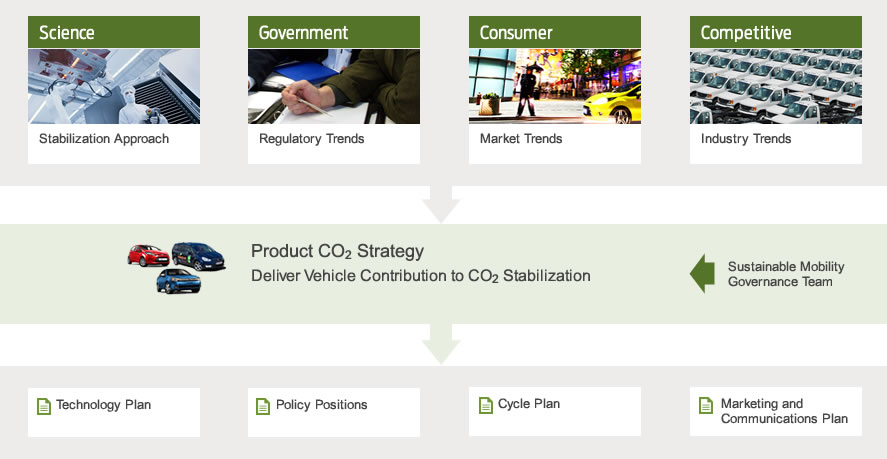Sustainability Report 2013/14
Climate Change and the Environment
Ford’s Climate Change Strategy
To respond to the risks and opportunities posed by the climate change issue, our long-term strategy is to contribute to climate stabilization by:
- Continuously reducing the greenhouse gas (GHG) emissions and energy usage of our operations;
- Developing the flexibility and capability to market lower-GHG-emission products, in line with evolving market conditions; and
- Working with industry partners, energy companies, consumer groups and policy makers to establish an effective and predictable market, policy and technological framework for reducing GHG emissions.
Our product plans in all regions are aligned with our overall goal of contributing to climate stabilization. Our technology and product strategy to meet this goal is based on the modeling of vehicle and fuel contributions to emission reductions and an analysis of market and regulatory trends (see figure below). Our climate change strategy is supported by our sustainable mobility governance, which establishes structures and accountability for implementing the strategy.
Product Sustainability Process

The specifics of our vehicle technology and product strategy to meet this goal are laid out in the Sustainable Technologies and Alternative Fuels Plan, which can be found in the Greening Our Products section of this report. The plan details steps we are taking in the foreseeable future to develop and deploy vehicle and fuel technologies.
We believe this strategy is already showing results by positioning our company to take advantage of opportunities created by shifts in markets. We have implemented all of the near-term actions of our plan, and our commitment to outstanding fuel economy aligns well with consumer interest in fuel-sipping vehicles. For example, from 2009 to 2013, industry sales of more fuel-efficient vehicles including subcompact cars, compact cars, mid-sized sedans, and small SUVs increased by 57 percent. Sales of more fuel efficient vehicles also grew faster than overall industry sales, which grew by 51 percent from 2009 to 2013. Ford’s sales of these vehicles increased even more than the industry overall, increasing by 67 percent from 2009 to 2013. However, from 2012 to 2013, industry-wide sales of these more fuel efficient vehicles grew a bit more slowly than overall vehicle sales; they increased by 8 percent, while overall industry sales grew by 9 percent. For the longer term, we are preparing to provide regionally appropriate approaches based on global platforms and advanced vehicle technologies, including electric vehicles, biofuel vehicles and (as fuel and infrastructure become available) hydrogen fuel cell vehicles. In addition, we have conducted dialogues with stakeholders, exploring sustainable mobility projects to demonstrate mobility solutions that meet the needs of urban and rural communities by leveraging information technology to integrate private and public transportation options. Please see the Financial Health section for details on these efforts.
Related links
This Report
© 2014 Ford Motor Company